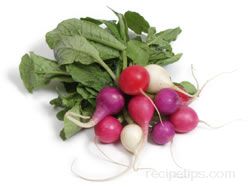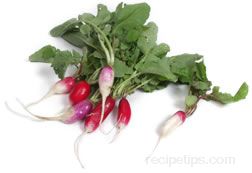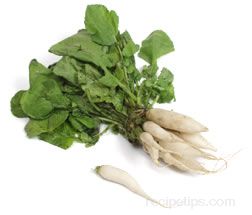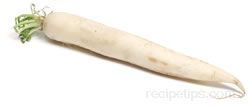|
Radish Preparation | Radish Cooking Tips
| Radishes |
|
     
A root vegetable related to the turnip and horseradish family, with a crisp texture and a peppery hot flavor. The hotness of the radish varies from mild to very strong, depending on the age and type. The different types come in a variety of sizes, shapes, and colors. The most commonly found are the small, round Cherry Belle, the Red Globe radish or the white carrot shaped variety known as Daikon. There are two main categories of radishes, either the spring or winter radishes, based on the time when they are harvested. Spring radishes, which have a short growing season, resulting in a smaller radish. Spring radishes are generally eaten raw. The winter radishes have a longer growing season, which results in a larger round or more elongated shaped vegetable that stores longer. Winter radishes are generally cooked. |
| Uses:
The red globe radish, one of the most commonly found radishes, can be served as hors d'oeuvres, as complements to salad or sandwiches, or as a garnish, adding a peppery hot flavor. Spring radishes are somewhat milder and are often enjoyed in foods as an ingredient or as a garnish. Winter varieties and are often used as a garnish for food dishes such as fish and poultry, sautéed and braised to be served as a vegetable dish, or diced and added to soups and stews. |
|
At Their Best:
Radishes are available year round. Radishes grown and harvested when temperatures remain hot, develop an increased bitterness. If the pungency of the radish is too strong, it can be reduced by salting and washing the radish to draw out the peppery flavor, by steaming the radish for 5 to 10 minutes, or by baking the radish with other vegetables. |
|
How to Buy:
When selecting, choose radishes that are firm, crisp, and without blemishes. If the greens are still on the radishes, they should look fresh and green. |
|
Storage:
Store without the leafy tops and place in the refrigerator to keep fresh for four to seven days if they are the spring varieties, or two to four weeks if they are winter radishes. The larger varieties, such as the watermelon, are similar to turnips for storing and can be kept longer or stored in a cool dry area. |
| Varieties: |
|
Red Globe Radish

|
One of the most popular and commonly found radishes. Although it is a spring radish, it is generally available thoughout the year but more abundant in the spring. Red Globe radishes are served as hors d'oeuvres, as complements to salad or sandwiches, or as a garnish, have a peppery hot flavor. |
|
Beauty Heart Radish
 |
A large round root vegetable, with a crisp texture and a mild to sweet peppery flavor. Unlike many other radishes, the intensity of this radish decreases as the radish matures. Generally, the flesh of this radish is hotter toward the outside and sweeter toward the center. The beauty heart radish grows to approximately three inches in diameter, displaying a white outer skin at the top with green shoulders and a pink base that covers a bright red to magenta inner flesh. Though considered to be a spring radish, it may be available throughout the year. This radish can be cooked like a turnip, creamed and served as a side dish, sautéed and braised to be served as a vegetable dish, or added to stir-fry dishes. The skin can be removed prior to preparing. It can also be served raw to be used as hors d'oeuvres, as a complement to salads and sandwiches or diced for use in soups and stews. The color of the inner flesh makes it an attractive sliced radish for an appetizer tray or for sandwiches. This radish may also be referred to a Watermelon, Rose Heart, Shinrimei, Misato, Asian Red Meat, or Xin Li Mei radish. |
Black Radish
 |
A root vegetable with a sooty dull black exterior that covers a white, crisp inner flesh providing a peppery hot flavor. The intensity of this radish can vary from mildly hot to very pungent and somewhat bitter, depending on the age and size, tasting somewhat like horseradish. The Black radish can be either round or elongated in shape. As a round radish, it can grow from two to six inches in diameter. Although considered a Winter radish, which tend to have a milder, more delicate peppery flavor, the Black radish can be very strong and pungent. This radish may be cooked like a turnip, creamed and served as a side dish, sautéed and braised to be served as a vegetable dish, or added to stir fry dishes. The skin is generally removed prior to preparing. It can also be served raw to be used as hors d'oeuvres, as a complement to salads and sandwiches or diced for use in soups and stews. This radish is also referred to as a Spanish Black radish. |
Easter Egg Radish
 |
A root vegetable with a crisp texture and a peppery hot flavor. The hotness of the radish varies from mild to very strong, depending on the age and type. The different types come in a variety of sizes, shapes, and colors. The Easter Egg radish is a spring radish harvested early in the growing season resulting in a smaller radish. The Easter Egg radish varies in color, ranging from a light shade of pink to dark crimson red, and provide a milder flavor. They are typically served as hors d'oeuvres, as complements to salad or sandwiches. |
|
French Breakfast Radish

|
A root vegetable related to the turnip and horseradish family, with a crisp texture and a mild to delicately sweet flavor. The French Breakfast radish has an elongated shape that can grow to approximately three inches in length, displaying a bright red outer skin, which turns white at the root base. This radish is considered to be a spring radish, but may be available throughout the year. It is a radish that is generally served raw to be used as hors d'oeuvres or a complement to salads. Radishes grown and harvested when temperatures remain hot develop an increased bitterness. It is also known as a Flambo radish. |
Icicle Radish
 |
A root vegetable related to the turnip and horseradish family, with a crisp texture and a peppery hot flavor. The Icicle radish is considered a spring radish. The winter radishes are harvested later in their growth and result in a more elongated shaped vegetable. The Icicle can be served as a hors d'oeuvre, as a garnish for salads or sandwiches, or simply as a snack. |
Daikon Radish
 |
An Asian root vegetable that is a long, white, carrot shaped radish that is crisp and juicy with a milder taste than red radishes. Considered a winter radish, the Daikon can be cooked for a long time without losing its taste and texture. It can be sliced or grated for use in salads and it is also popular cooked or pickled. Also known as Mooli, Chinese white radish and Japanese radish. |
Radish Preparation
Radishes are not usually peeled during preparation unless asked for in a recipe. Peeled radishes are milder in flavor than unpeeled radishes. To prepare a radish, simply slice off the roots and leaves, wash under cold running water, and drain. Depending on what a recipe calls for, radishes are served whole, sliced, diced, minced, and/or grated.
Radish Cooking Tips
- The process of cooking radishes tames the harshness.
- To enhance the red coloring of a radish while cooking, add a bit of lemon juice to the cooking liquid.
- Boil: Bring water to a boil, carefully drop in whole or sliced radishes. Simmer radishes until they become just tender, from 10 to 30 minutes depending on the type of radish.
- Steam: Steam whole radishes in steamer for 5 to 15 minutes, depending on desired tenderness.
- Roast: Preheat oven to 425º F. Toss sliced radishes with olive oil, and favorite seasonings. Spread radishes onto baking sheet or roasting pan.Roast for 30-45 minutes, until tender and browning.
|





















